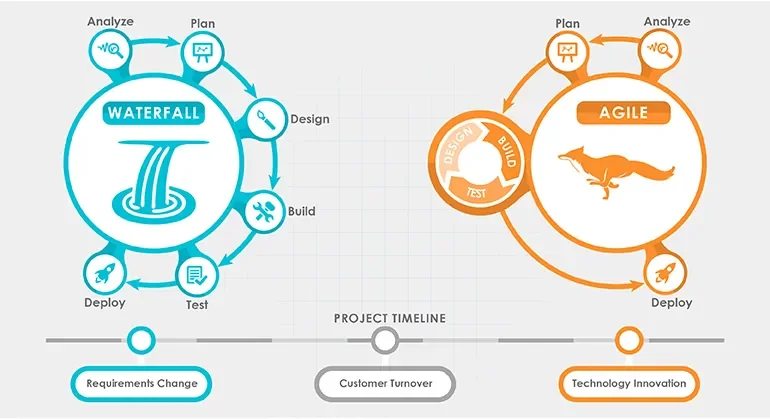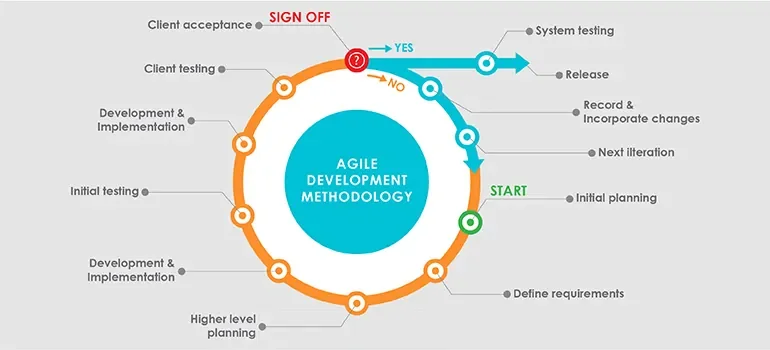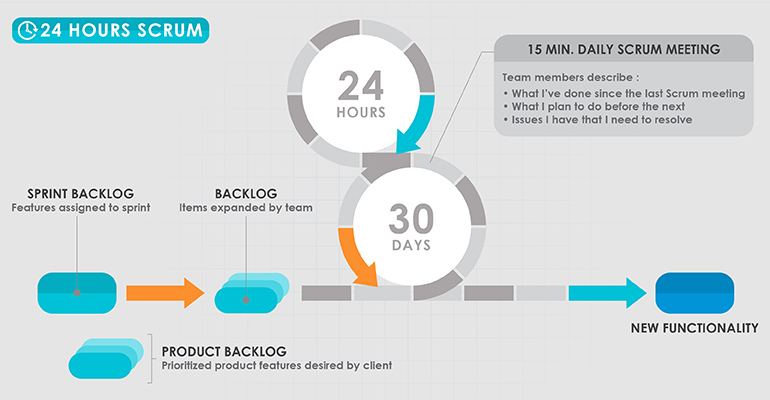The ADDIE and Agile frameworks are two development methodologies that are leveraged to guide L&D teams through a project. The philosophies of the ADDIE and Agile methodologies share many of the same practices. Both the Agile and ADDIE methodologies include analysis, design, development, implementation, and evaluation as part of their process, but the Agile methodology has distinct characteristics that set it apart from ADDIE. The incremental organization, flexible schedule, collaborative and transparent process are characteristics of a project using the Agile methodology, but how is this different from ADDIE?
1. Organization
First of all, the methodologies differ in the distinctive way the practices are organized. The Agile methodology merges ADDIE’s practices of analysis, design, development, implementation and evaluation into two-week sprints. A “sprint” or “iteration” is a short period in which the e-learning team implements and delivers a product increment for evaluation.
The ADDIE methodology organizes the practices into five sequential phases, each phase undergoing a process designed to achieve a definition strong enough to propel e-learning teams into each subsequent phase of the learning design process. For example, the analysis phase of ADDIE defines the business requirements such as the end user needs, cost estimates, and schedules. The business requirements are defined and documented prior to moving onto the next phase. This linear relationship between the five practices in ADDIE is in contrast to the Agile methodology where the five practices work together incrementally, in short, recurring sprints.

2. Flexibility
Increasingly, E-learning teams are adopting the Agile approach to meet the dynamic needs of businesses. The Agile methodology allows e-learning teams to flex with shifting content, constant updates to processes and changing directions from stakeholders. The linear waterfall method that characterizes the traditional ADDIE methodology is fundamentally challenged in the face of changing business requirements. While the ADDIE methodology rigidly emphasizes a linear process dependent upon predefined business requirements, the Agile methodology allows e-learning teams to rapidly respond to shifting business requirements throughout the lifecycle of the project.
3. Collaboration
In the Agile Methodology, collaboration is a fundamental element of the process, much more so than in ADDIE. The e-learning teams using the ADDIE methodology collaborate routinely, especially during each milestone in the project; however, the e-learning team and project stakeholders have the freedom to establish a collaborative relationship on their own terms without the governance of the ADDIE framework to determine the meeting dates and times. The Agile methodology has embedded daily meetings between project stakeholders and e-learning teams referred to as “daily stand-ups” into its model. Daily stand-ups make space for stakeholders and e-learning teams to discuss priorities and objectives for the day, accomplishments from the previous day, and any outstanding issues delaying progress.
Further, the ADDIE methodology emphasizing quality at the end of the process during the “Evaluation” phase. It is during this phase that e-learning teams and project stakeholders work together to determine the effectiveness of the work product and make any adjustments. This is in contrast to the Agile methodology that works in “sprints” or “iterations”, short, two-week periods in which the e-learning team implements and delivers a work product increment for evaluation to ensure quality. The evaluation at the end of a sprint creates a collaborative space for e-learning teams and project stakeholders to discuss the quality of the iteration, discover any issues, and prioritize tasks and sub-tasks before beginning work on the next sprint. While collaboration is a key ingredient to the success of any project, common sense is not always common practice.

4. Transparency
The Agile methodology requires a greater degree of transparency than the traditional waterfall method. E-learning teams working Agile submit an iteration of a work product for evaluation at the end of every sprint as opposed to the ADDIE methodology, where a work product is delivered all at once and near the end.
Transparency between e-learning teams and stakeholders is expected when working Agile because regular evaluations of work product deliverables are scheduled at the end of every sprint. The transparency provided by frequent evaluations allows e-learning teams and stakeholders to uncover any issues in the project and address them before any further work is done. A transparent approach is an opportunity to reaffirm a mutual understanding of the project’s direction by the stakeholders and e-learning team.

Drawbacks to the Agile Methodology
While the Agile methodology allows e-learning teams to flex to dynamic and ever-changing business requirements, the Agile methodology is not without its drawbacks. To start, Agile projects do not run with a fixed cost model. Business requirements evolve throughout the lifecycle of an agile project and such unpredictability makes it difficult to determine definite timelines and negotiate fixed prices accordingly.
Frequent deliverables and the need to get each work product approved is demanding and time-consuming, requiring the availability of representatives on the client side such as the subject matter experts and the end users. Frequent delivery also puts a lot of pressure on e-learning teams to deliver high quality deliverables within a very short period. The pressure on e-learning teams to get it right the first time is unyielding and persists with every two-week sprint.
Finally, Agile projects often involve heavy client participation. Too much client involvement can stall the development of a project. Stakeholders who want to wait for feedback from other internal stakeholders or differ a decision to other executives within the client organization can hinder the development process. As the saying goes, too many cooks in the kitchen can spoil the broth.
Both ADDIE and Agile have their place in L&D. Understanding the project requirements or lack thereof can help e-learning teams determine which framework is better suited for a given project. Consider the organization of each framework, the level of commitment the e-learning team is prepared to make towards routine meetings, and the degree of flexibility and transparency the e-learning team is comfortable with before choosing the Agile or ADDIE framework. In our free eBook The Agile Guide to Agile Development, we’ve talked about the ten steps that can help a team’s transition to Agile project management. Then, try each framework on and see what fits.



